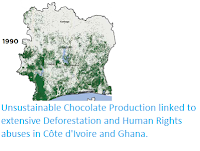At least eighteen people died in flooding in Abidjan, Côte d'Ivoire, on Monday 18-Tuesday 19 June 2018, with over a hundred needing to be rescued by emergency services and many more escaping on their own. The flooding was caused by torrential rain overnight, associated with the West African Rainy Season, which has been particularly severe this year due to high temperatures over the Gulf of Guinea, leading to more water evaporating from the sea surface, and therefore more falling on land.
The rains began at about 11.00 pm, and persisted till about 6.00 am, causing a sting of flash floods that in places reached 2.5 m deep. Abidjan has become increasingly prone to flash flooding due to
rapid urban expansion in the area (the population of Côte d'Ivoire has doubled since 1990), which is built on an area of
historic coastal wetlands, preventing rainwater from draining
into the soil and raising the dangers of flooding in the city.
June falls in the middle of the rainy season in Abidjan, with the city receiving an average of 568.1 mm of rain during the month. West Africa has a distinct two season climatic cycle, with a cool dry
season during the northern winter when prevalent winds blow from the
Sahara to the northeast, and a warm rainy season during the northern
summer when prevalent winds blow from the Atlantic Ocean to the
southwest. These warm winds from the Atlantic are laden with moisture,
which can be lost rapidly when the air encounters cooler conditions,
such as when it is pushed up to higher altitudes by the Ivorian plateaux.
Rainfall and prevalent winds during the West African dry and rainy seasons. Encyclopedia Britanica.
See also...
Follow Sciency Thoughts on Facebook.








